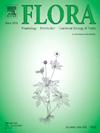Siliceous phytoliths in species of the Costaceae and Zingiberaceae families of Sri Lanka
IF 1.7
4区 生物学
Q3 ECOLOGY
引用次数: 0
Abstract
Phytoliths, due to their distinctive characteristics and durability, are valuable tools for identifying plant taxa, but their broader application is hindered by limited knowledge. This study aimed to identify phytolith forms and their key discriminative features—shape, margin features, surface ornamentation, and size—in 4 species from the family Costaceae and 14 species from the family Zingiberaceae that grow in Sri Lanka, with the goal of exploring their potential use in taxonomic identification. We also investigated the phytolith mass (per unit weight) among plant species or different plant parts. Phytoliths in leaf, pseudo-stem, and petiole samples (n = 3) from these species were extracted using the wet-oxidation protocol. The samples from species that did not respond were subjected to a modified wet-oxidation protocol, but only Zingiber officinale and Z. zerumbet responded to this protocol. A total of ten phytolith forms were identified across eleven species. Phytolith forms in Hellenia speciosa, Curcuma aromatica, C. zedoaria, and Etlingera elatior are distinctive and allow for their taxonomic identification. However, some species exhibited similar phytolith forms, making taxonomic identification based solely on phytoliths impossible. Although Zingiber officinale Type I phytoliths are SPHEROIDAL NODULATE, this species can still be distinguished by its unique Type II phytoliths (PYRAMIDAL NODULATE), which are specific to Z. officinale. In all species, phytolith shapes were consistent across all plant parts (p > 0.05). With the exception of Hellenia speciosa, phytolith size varied significantly depending on the plant part (p < 0.05). Additionally, the mass of phytoliths per unit weight differed significantly between species and among plant parts (p < 0.05), with the highest mass found in leaves. Notably, we identified new phytolith features, contributing to the refinement of phytolith nomenclature. Our findings highlight the potential of phytolith analysis for plant identification and underscore the need for further research to enhance its broader applicability in multidisciplinary studies.
求助全文
约1分钟内获得全文
求助全文
来源期刊

Flora
生物-植物科学
CiteScore
3.30
自引率
10.50%
发文量
130
审稿时长
54 days
期刊介绍:
FLORA publishes original contributions and review articles on plant structure (morphology and anatomy), plant distribution (incl. phylogeography) and plant functional ecology (ecophysiology, population ecology and population genetics, organismic interactions, community ecology, ecosystem ecology). Manuscripts (both original and review articles) on a single topic can be compiled in Special Issues, for which suggestions are welcome.
FLORA, the scientific botanical journal with the longest uninterrupted publication sequence (since 1818), considers manuscripts in the above areas which appeal a broad scientific and international readership. Manuscripts focused on floristics and vegetation science will only be considered if they exceed the pure descriptive approach and have relevance for interpreting plant morphology, distribution or ecology. Manuscripts whose content is restricted to purely systematic and nomenclature matters, to geobotanical aspects of only local interest, to pure applications in agri-, horti- or silviculture and pharmacology, and experimental studies dealing exclusively with investigations at the cellular and subcellular level will not be accepted. Manuscripts dealing with comparative and evolutionary aspects of morphology, anatomy and development are welcome.
 求助内容:
求助内容: 应助结果提醒方式:
应助结果提醒方式:


